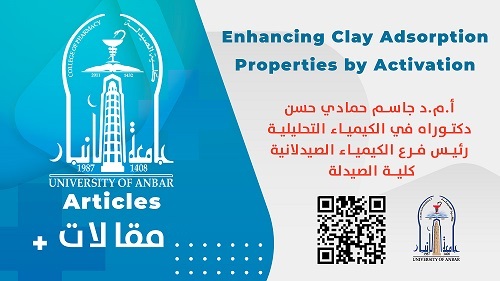
تحسين خصائص امتصاص الطين عن طريق التنشيط
Enhancing Clay Adsorption Properties by Activation
تحسين خصائص امتصاص الطين عن طريق التنشيط
College of Pharmacy, University of Anbar
دكتوراه في الكيمياء التحليلية
رئيس فرع الكيمياء الصيدلانية
Clay minerals are common in shales and rocks, and they are among the most important materials on the planet's surface. Weathering of rocks or crystallization of silicates and aluminates solutions can produce them. Clay minerals are made up of two-dimensional arrays of silicon-oxygen tetrahedral and aluminium- or magnesium-oxygen-hydroxyl octahedral.
Clay activation is the process of subjecting clay to chemical or thermal treatment or grinding in order to improve its adsorption capabilities. Sodium carbonate or strong acids like sulfuric acid are commonly utilized in chemical activation.
The acid activation of clay minerals is undoubtedly one of the most effective processes for producing active materials for adsorption and catalysis.
Clay can be activated by treatment with a different types of acids like HCl, H2SO4, H3PO4. After treatment with a specific compound, the mixture of clay-compound is stirred for 24 hours, then the slurry was emptied in a Büchner funnel to obtain the clay sample. The clay sample then washed several times with distilled water until a neutral pH and dried at 110 oC for 10 hours.
Acid treatment of clays alters the structure of the clay by forming new pores, resulting in an increase in surface acidity due to the substitution of cations such as A3+, Fe3+, and Ca2+ with H+. Acid-activated clay is almost saturated with H+ and has a high acidic nature for the reasons stated above. Clay can be activated with any mineral acid, but hydrochloric and sulfuric acids are the most popular.
The clays can be activated by thermal treatment via firing to various temperatures.
Clays can also be activated by grinding process. Any material's grindability can be summarized as an increase in specific surface area per unit of applied grinding energy. Depending on the objective particle size distribution, the grinding process can be categorized into coarse, intermediate, and fine grinding. The grinding process is strongly influenced by the mechanical qualities of the processed material, such as hardness, toughness, elasticity, and plasticity, as well as the process regime, interaction phenomena, and environmental variables. Mechanochemical activation is a type of grinding that aims to cause structural changes, amorphization, and so increase the chemical reactivity of the processed material in addition to reducing particle size distribution. The method is extensively employed in the mining industry, food processing, and the production of pharmaceutics and chemicals. Because it eliminates the use of chemicals and high temperatures, it is considered an environmentally beneficial process.




